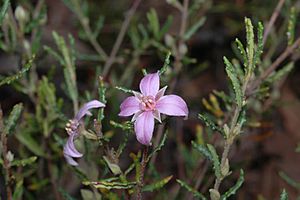Granite rose facts for kids
Quick facts for kids Granite boronia |
|
|---|---|
 |
|
| Boronia repanda in the Australian National Botanic Gardens | |
| Conservation status | |
| Scientific classification | |
 |
|
| Occurrence data from Australasian Virtual Herbarium |
The Boronia repanda, also known as the granite rose or border boronia, is a special plant. It belongs to the citrus family called Rutaceae. This plant is endemic, meaning it only grows naturally in a specific area. For the granite boronia, this area is near the border between New South Wales and Queensland in Australia.
It's a small, upright, woody shrub with many branches. Its leaves are thick and have a warty feel. The plant produces pretty pink flowers, though sometimes they can be white. These flowers grow one by one where the leaves meet the stem.
What Does the Granite Boronia Look Like?
The Boronia repanda is an upright, woody shrub. It can grow to be about 0.3–1.5 m (1–5 ft) tall. Its young stems and leaves are covered with tiny, white, star-shaped hairs.
Its leaves are simple and shaped like an oblong. They are usually 4–18 mm (0.2–0.7 in) long and 1.5–3 mm (0.06–0.1 in) wide. The leaves are thick and have noticeable bumps, like warts. They attach to the stem with a small stalk called a petiole, which is about 0.5–1.5 mm (0.02–0.06 in) long.
The flowers are mostly pink, but sometimes they are white. Each flower grows alone where a leaf joins the stem. They sit on a small stalk called a pedicel, which is about 1.5–4 mm (0.06–0.2 in) long.
The plant has four sepals, which are like small leaves that protect the flower bud. They are narrow and triangular, about 3–4.5 mm (0.1–0.2 in) long. There are also four petals, which are the colorful parts of the flower. These petals are 6–9 mm (0.2–0.4 in) long and 3–4 mm (0.1–0.2 in) wide. Both the sepals and petals grow larger as the fruit develops.
The granite boronia has eight stamens, which are the parts that produce pollen. They are different lengths. The plant's style, which is part of the female reproductive organ, is hairy.
The granite boronia usually flowers from July to November. After flowering, it produces a hairy fruit. This fruit is a capsule about 4–5 mm (0.16–0.20 in) long and 2 mm (0.08 in) wide.
Where Does the Granite Boronia Grow?
The granite boronia is found in a few specific places. It grows in nine different areas within the Granite Belt and Darling Downs regions of south-east Queensland. There is also one known group of these plants in the Northern Tablelands area of New South Wales. This spot is very close to the Queensland border.
This plant prefers to grow in heathlands and woodlands. It especially likes areas where the soil is made of granite.
Why is the Granite Boronia Endangered?
The Boronia repanda is considered an "endangered" species. This means it is at a high risk of disappearing forever. Different Australian laws protect it, including the Australian Government's Environment Protection and Biodiversity Conservation Act 1999. Queensland and New South Wales also have their own laws to protect it.
There are a few main reasons why this plant is in danger:
- Clearing Undergrowth: Sometimes, people remove smaller plants and bushes (undergrowth) to reduce the risk of bushfires. This can harm the granite boronia, as it removes its habitat.
- Incorrect Fire Management: Fires are a natural part of the Australian environment, but if they happen too often, not often enough, or at the wrong time, they can damage plant populations.
- Limited Numbers: There are only a small number of granite boronia plants left in the wild. This makes them more vulnerable to threats.
Protecting these plants is important to make sure they survive for future generations.


